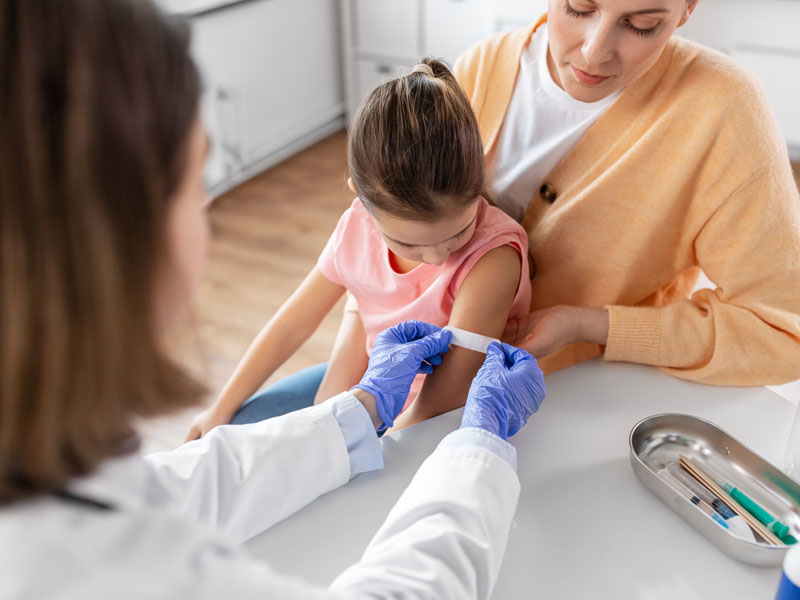Study Finds Mixed Results on Early Childhood Vaccination
Authors Suggest Several Strategies
Aug. 30, 2023, News Staff — New research illustrates challenges but also offers encouraging news for family physicians who work to ensure that children receive their immunizations on time. This can be a complex effort, as the CDC’s child and adolescent immunization schedules call for multiple doses of the same vaccines for maximum protection.

The research, a cross-sectional analysis of 2019 National Immunization Survey data, published this month in Pediatrics, indicates that many children do not complete many multidose vaccine series.
At the same time, analysis showed that coverage rates for many childhood vaccines exceeded 90%, and a substantial number of children needed only one remaining dose from a multidose vaccine to complete their combined vaccine series. Had these children received the additional dose, the United States would have reached an important vaccination coverage target of 80% completion of the combined seven-vaccine series established in HHS’ Healthy People 2020 initiative.
Key Findings
Researchers examined immunization rates for the combined seven-vaccine series (for diphtheria, tetanus and acellular pertussis; Haemophilus influenzae type b; hepatitis B; measles, mumps and rubella; pneumococcal disease; polio; and varicella) among 16,365 children from 19 to 35 months old.
Overall, less than 73% of the children completed the series, just under 10% had not initiated one or more vaccinations, and slightly more than 17% initiated but did not complete one or more multidose series. In addition, 1.1% of children were completely unvaccinated for the combined series, an increase from 0.8% in 2012.
Moving across state lines since birth, having two or more children in the household, and lack of health insurance were all strongly associated with initiating but not completing the series. Other risk factors included lower household income levels and living in a rented home. Compared with non-Hispanic white children, non-Hispanic Black children also were at increased risk of not completing the series.
Story Highlights
On the positive side, the percentage of young children who received the recommended doses in the series increased from 68.4% in 2012, the Healthy People 2020 initiative’s baseline, to 72.9% in 2019.
In addition, four vaccines in the series had coverage that exceeded the initiative’s 90% target rate, with polio the highest at 92.3%.
And while coverage rates for the remaining three vaccines (DTaP, Hib and pneumococcal disease) did not meet Healthy People 2020 targets, they were all slightly higher than the baseline.
Finally, the researchers noted that 8.4% of children in the study population needed only one additional dose from a multidose vaccine series to have completed the combined seven-vaccine series.
Recommendations to Improve Coverage
The authors suggested several tactics to improve vaccine series completion, including giving reminders, administering vaccines outside of the primary care setting, offering flexible scheduling, using automated prompts at the point of care, and planning ahead of scheduled visits.
At the same time, they observed that vaccine coverage gaps still exist, especially in lower-income households and for those who lack health insurance. In these cases, the authors recommended helping to connect patients with the federal Vaccines for Children program and coordinating insurance enrollment for eligible uninsured children.
For children who have moved or have incomplete or missing immunization records, the authors also recommended relatively new efforts, such as the use of immunization coordinators from state and local health departments, and increased communication among state immunization information systems.
“Optimizing timely multidose series completion in the first two years of life is necessary for disease protection and durable immunity for individuals, as well as to develop and maintain herd immunity at a population level,” the authors concluded. “Our findings regarding socioeconomic and racial and ethnic disparities indicate that established strategies for facilitating multidose series completion, such as reminder-recall are not reaching all communities. Renewed efforts to better support timely completion of multidose vaccine series in early childhood are needed to achieve vaccination coverage goals.”
AAFP Resources
The Academy has a plethora of fact sheets and guidance documents to assist family physicians in improving childhood vaccination rates, including
- “How to Approach Conversations With Parents About Routine Pediatric Vaccinations” and “Building Confidence When Talking to Parents About Children’s Vaccines,” which include sample messages and answers to common vaccine-related questions;
- “What Your Doctor Wants You to Know About Vaccines for Kids,” which explains the importance of childhood vaccination;
- “Messages to Use in Vaccine Communications,” a collection of email templates to remind parents and caregivers about their children’s vaccine schedules; and
- “Explaining the Vaccine Safety System,” which helps FPs talk with patients about how vaccines are developed and reviewed before approval.
Additional resources, such as the latest immunization schedules, CME activities and more are available at the Academy’s Immunizations and Vaccines webpage and familydoctor.org’s Immunizations webpage.